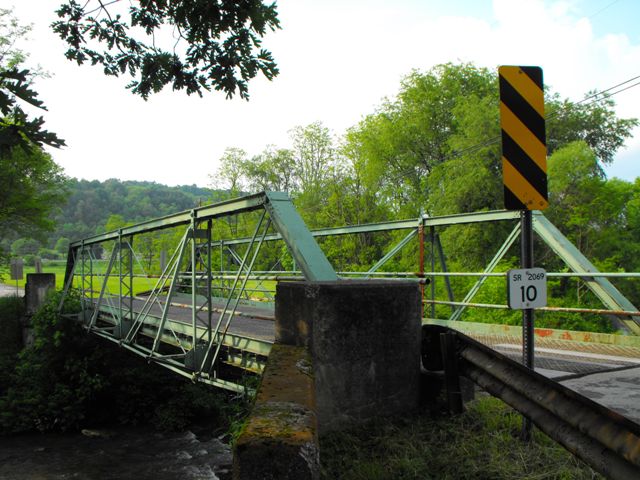We Recommend:
Bach Steel - Experts at historic truss bridge restoration.
BridgeHunter.com Phase 1 is released to the public! - Visit Now
Plum Creek Road Bridge
Johnston Bridge

Primary Photographer(s): Nathan Holth and Rick McOmber
Bridge Documented: June 1, 2010
Rural: Armstrong County, Pennsylvania: United States
1927
72.0 Feet (21.9 Meters)
80.0 Feet (24.4 Meters)
14.4 Feet (4.39 Meters)
1 Main Span(s)
3206900100000

View Information About HSR Ratings
Bridge Documentation
This bridge no longer exists!
View Archived National Bridge Inventory Report - Has Additional Details and Evaluation
This historic bridge was demolished by PennDOT in 2011!
This bridge is an unaltered example of a pin-connected Pratt pony truss bridge. The bridge is traditionally composed, with one major exceptions which the historic bridge inventory failed to notice, which is that the last bottom chord eyebars at each end of the bridge angle up slightly; in other words, the bottom chord is polygonal. This is not a traditional detail and although it is not unheard of and a few other examples do exist, it is not common and should be considered significant.
The bridge has truss web members composed as follows: endposts and top chord: back-to-back channels with battens and cover plate, 12 inches by 6.5 inches; vertical members: two paired angles with v-lacing between, 12 inches by 4 inches; diagonal members: loop-forged and up-set eyebars; bottom chord: up-set eyebars.
The historic bridge inventory's findings for this bridge are extremely dated. Because PennDOT has elected to demolish so many metal truss bridges in the Commonwealth, there are nowhere near 120 pin-connected truss bridges built before 1900 statewide. The eligibility of those bridges which remain must be revaluated to provide an accurate historic bridge inventory. Unaltered pin-connected truss bridges should be considered historically significant, even if they are late examples.
Despite its rural location and potential for rehabilitation for continued light vehicular use, this bridge was sentenced to the dumpster, with an ugly slab of pre-stressed box beams planned in its place to function as a so-called bridge.
Information and Findings From Pennsylvania's Historic Bridge InventoryDiscussion of Bridge The 1904, skewed, single span, 80'-long, pin connected Pratt pony truss bridge is supported on concrete abutments that date to 1927. The light trusses are traditionally composed, with built up box section upper chords, eye bar lower chords and diagonals, and steel angle verticals. One of nine pin connected truss bridges in Armstrong County, the bridge is a late and undistinguished example of its technology. It has no innovative or distinctive details, and it reflects the standardization of the design that dominated after about 1895. More than 120 pin connected truss bridges built before 1900 survive statewide. This late example is neither historically or technologically significant. Discussion of Surrounding Area The bridge carries 1 lane of a state road over a stream in a rural, agricultural area with undistinguished, predominantly late 20th-century residences, including trailer homes. The area does not have rural historic district potential. Bridge Considered Historic By Survey: No |
![]()
Photo Galleries and Videos: Plum Creek Road Bridge
Bridge Photo-Documentation
Original / Full Size PhotosA collection of overview and detail photos. This gallery offers photos in the highest available resolution and file size in a touch-friendly popup viewer.
Alternatively, Browse Without Using Viewer
![]()
Bridge Photo-Documentation
Mobile Optimized PhotosA collection of overview and detail photos. This gallery features data-friendly, fast-loading photos in a touch-friendly popup viewer.
Alternatively, Browse Without Using Viewer
![]()
Southbound Crossing of the Bridge
Full Motion VideoStreaming video of the bridge. Also includes a higher quality downloadable video for greater clarity or offline viewing.
![]()
Northbound Crossing of the Bridge
Full Motion VideoStreaming video of the bridge. Also includes a higher quality downloadable video for greater clarity or offline viewing.
![]()
Maps and Links: Plum Creek Road Bridge
This historic bridge has been demolished. This map is shown for reference purposes only.
Coordinates (Latitude, Longitude):
Search For Additional Bridge Listings:
Bridgehunter.com: View listed bridges within 0.5 miles (0.8 kilometers) of this bridge.
Bridgehunter.com: View listed bridges within 10 miles (16 kilometers) of this bridge.
Additional Maps:
Google Streetview (If Available)
GeoHack (Additional Links and Coordinates)
Apple Maps (Via DuckDuckGo Search)
Apple Maps (Apple devices only)
Android: Open Location In Your Map or GPS App
Flickr Gallery (Find Nearby Photos)
Wikimedia Commons (Find Nearby Photos)
Directions Via Sygic For Android
Directions Via Sygic For iOS and Android Dolphin Browser
USGS National Map (United States Only)
Historical USGS Topo Maps (United States Only)
Historic Aerials (United States Only)
CalTopo Maps (United States Only)


